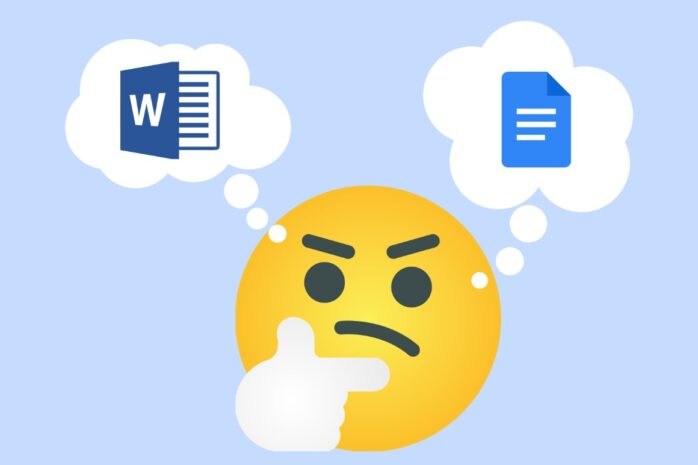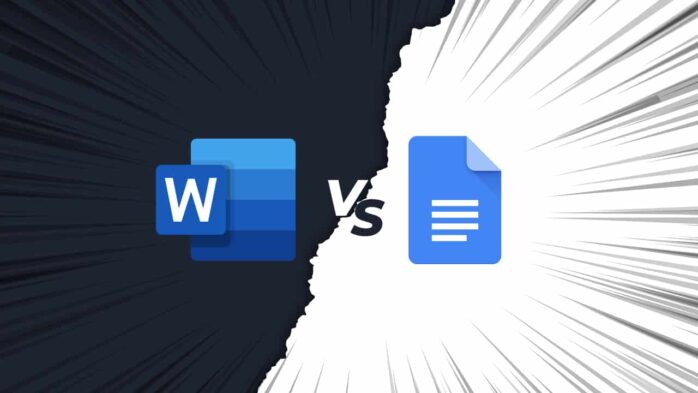Essential tools in today’s digital age are those that aid in document creation and word processing. Leading the charge in this domain are Google Docs, a product of tech powerhouse Google, and Microsoft Word, an integral part of Microsoft’s extensive Office suite.
Both come packed with robust features, and the choice between them often hinges on personal requirements, the specific task at hand, or allegiance to a brand. So, how do they compare when pitted against each other?
Let’s dive into a comprehensive comparison of Google Docs vs Word.
Google Docs operates as a cloud-centric word-processing platform, enabling users to craft, modify, and save documents on the web.
It’s a cog in Google’s expansive office toolkit, which encompasses Sheets, Slides, and Drive. Conversely, Microsoft Word has anchored the word processing sector since the 1980s.
While traditionally a software that one installs on a computer, Microsoft has transitioned to a cloud subscription model via Office 365, incorporating Word Online.
Features and Functionality

Google Docs
Interface & Usability: Google Docs is renowned for its minimalistic interface, which emphasizes simplicity and ease-of-use. This simplicity is beneficial for users who want straightforward word processing without the clutter.
Templates: Google Docs provides a range of templates for different purposes – from resumes to project proposals. However, compared to Word, the variety is limited.
Voice Typing: A standout feature in Google Docs is the Voice Typing tool, allowing users to dictate their document, which can be especially useful for users with disabilities or those who prefer vocalizing their ideas.
Explore Feature: Google Docs has an “Explore” function, which aids in researching topics directly from the document. It’s an integrated tool that can pull in data, images, and more, making content creation faster.
Scripting and Add-ons: With Google Script, users can automate tasks within Docs, although it might require some programming knowledge. The G Suite Marketplace also offers add-ons to increase functionality, though some advanced tools present in Word might be missing or less intuitive here.
Microsoft Word
Feature-rich Interface: Microsoft Word, having been in the industry for much longer, boasts an expansive set of tools and options. This means a steeper learning curve but offers power users the depth they require.
Advanced Formatting: Word gives users granular control over document formatting. Whether it’s styles, borders, shading, or advanced image editing, Word offers more in-depth customization than Google Docs.
Templates: Microsoft offers a broader range of professional templates for various purposes. With years in the industry, they’ve refined and expanded their template offerings, catering to diverse needs.
Advanced Features: Tools like Mail Merge, which integrates Word with databases (like Excel) to produce multiple documents, showcases Word’s depth. Features such as the Reference Tool, which aids in citation and bibliography creation, also stand out.
Integrations: Word seamlessly integrates with other Microsoft Office applications, such as Excel and PowerPoint. This ecosystem is beneficial for those who frequently switch between these apps.
Macros and Add-ins: For those looking to automate tasks or add specific functionalities, Word provides Macros – scripts that can automate repetitive tasks. The Office Store also boasts a myriad of add-ins, expanding Word’s capabilities further.
Integration and Add-ons

- Google Docs: As a component of the Google ecosystem, Google Docs offers smooth integration with other Google services such as Sheets, Slides, and Drive. Furthermore, the G Suite Marketplace provides a variety of add-ons to enrich its features.
- Microsoft Word: Word harmoniously connects with other Microsoft Office applications including Excel, PowerPoint, and Outlook. The Office Store presents a vast selection of add-ins to broaden its capabilities. Additionally, Microsoft’s collaboration with LinkedIn, post-acquisition, introduces distinct advantages, particularly for crafting resumes.
Accessibility and Collaboration
- Google Docs: One of the standout features of Google Docs is its real-time collaborative capabilities. Multiple users can edit a document at the same time, with each person’s edits visible in different colors. Comments and suggestions can be made on the side, and the chat feature facilitates communication between collaborators. Since it’s cloud-based, accessing your documents from any device with an internet connection is a breeze.
- Microsoft Word: Word, via Office 365, has caught up with Google Docs in terms of collaboration. Word Online offers real-time editing
with collaborators, but traditionally, the desktop version of Word wasn’t built with collaboration as a primary focus.
However, with integration to OneDrive, Microsoft’s cloud storage, you can now collaborate in real-time on documents saved to the cloud.
Accessing documents from multiple devices is also feasible, but it does require users to save their documents on OneDrive.
Security
- Google Docs: Renowned for its stringent security measures, Google Docs offers enhanced safety options, including two-factor authentication and encryption during transit. Leveraging Google’s expansive infrastructure, significant investments are made to safeguard user information.
- Microsoft Word: Security remains a top priority for Microsoft as well. The integration of Advanced Threat Protection and Data Loss Prevention in Office 365, along with OneDrive’s Personal Vault for confidential files, ensures Word caters to users valuing high-grade security.
Pricing
- Google Docs: A standout benefit of Google Docs is its no-cost access for individual users. For businesses seeking enhanced features and additional storage, there’s Workspace (formerly G Suite) available at a charge.
- Microsoft Word: Word comes bundled with the Office suite, which carries a price tag. Through Office 365, Microsoft’s subscription offering, users gain both online and offline access to Word and other Office applications. Still, a scaled-down version of Word Online is accessible for free to individual users, though with some feature limitations.
Offline Access
- Google Docs: While Google Docs is primarily web-based, it does offer an offline mode. This feature lets users modify documents without internet access, which will later synchronize when connectivity is restored.
- Microsoft Word: The traditional desktop version of Word works seamlessly offline. However, for Word Online, internet access is essential. Nevertheless, through OneDrive integration, users can make offline adjustments, which then synchronize upon reconnection.
Conclusion

Deciding between Google Docs and Microsoft Word is primarily influenced by individual or business preferences.
If cost-free cloud access and instantaneous collaboration are paramount for you, Google Docs shines as an optimal pick.
On the other hand, for those seeking a comprehensive feature set, intricate integrations, and are amenable to a premium offering, Microsoft Word is a standout.
Each platform boasts its merits, catering to diverse user needs.
It’s prudent to delve into both and ascertain which one resonates more with your distinct necessities.
Regardless of the selection, both Google Docs and Microsoft Word persistently redefine the contours of digital word processing in their distinctive manners.



















